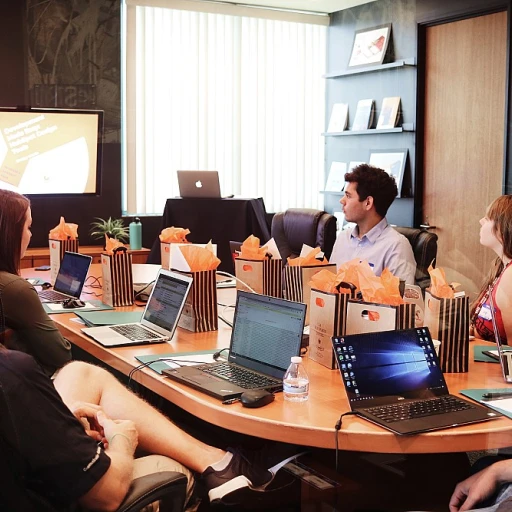
Understanding the Importance of Succession Planning
The Vital Role of Succession Planning in Organizational Success
Succession planning is a crucial aspect of ensuring the longevity and health of any organization. It involves not just filling positions but nurturing an environment of development and leadership growth. Investing time and resources into this area impacts the entire system, from the human resources department to the program leaders.
Effective succession planning can serve as a solid foundation for change management, addressing organizational shifts seamlessly with minimal disruption. The process encompasses identifying and developing future leaders at various levels, from students in leadership development programs to adult learners keen on advancing within the organization.
Succession planning isn't simply about preparing a list of potential candidates for key roles. It’s about organizational development, referred to as developing a culture that fosters growth and adaptability. This involves continuous learning and skill acquisition through formal training courses, informal mentorship, and via exposure to different organizational functions.
Mastering the art of succession planning is cost-effective and empowers teams to be ready for tomorrow's challenges. As businesses evolve, the need for solid succession planning becomes more evident, influencing not only the strategic management of an organization but also its operational dynamics.
Organizational leaders and human resources must collaborate to structure focused inquiries that uncover potential in all corners of the organization. Courses, leadership development programs, and other educative interventions should be aligned with the strategic needs of the organization, fostering growth and preparing future leaders effectively for key roles.
Identifying Key Roles and Potential Successors
Pinpointing Crucial Roles and Matching Successors
Understanding which roles are vital in your organization forms the bedrock of effective succession planning. It's essential for those involved in management and leadership to identify positions that require a seamless transition during a change in personnel. This proactive step aims to minimize disruption and ensure continual organizational productivity and stability. To effectively identify key roles, consider these steps:- Analyze Organizational Impact: Assess each role's impact on the organization. Emphasize roles that significantly contribute to strategic objectives or are instrumental in organizational development.
- Evaluate Leadership Needs: Determine which positions demand strong leadership qualities and have direct influence over teams, decision-making processes, or critical operations.
- Weekly Team Reviews: Conduct regular evaluations with teams and department heads (HOD) to ascertain which roles are indispensable. This should include insights from human resources to gauge future needs based on organizational growth and direction.
- Outreach to Adult Learners: Incorporating focused inquiries and studies on adult learners enrolled in leadership development programs, such as a school-based organizational leadership degree, can provide fresh perspectives on potential candidates.
- Leadership Development Programs: These can serve as a pipeline for assessing potential successors. Programs should be structured to offer credit hours and address both leadership and human development. Engaging employees in video introductions and course videos can aid in their learning development journey.
- Adult Education Opportunities: Supporting employees through further education, such as management courses or development interventions, empowers them with the skills required for succession.
- Pilot a Mentorship Scheme: Pairing promising individuals with current role incumbents through structured management mentoring or semester-long adlt learning schemes can facilitate hands-on experience. This should include opportunities for them to contribute to team decision-making.
Developing Talent from Within
Internal Cultivation of Talent
Developing talent within an organization demands a robust approach to nurture individuals as they advance in their roles. It's not merely about identifying potential but also about fostering growth through structured leadership development programs and focused inquiry. Organizations must ensure that these adlt learners and young professionals are equipped with the necessary skills for seamless transitions into more senior roles.- Implement targeted organizational development initiatives to enhance employees' skills and prepare them for future leadership. This approach supports long-term human capital strategies by systematically building capabilities.
- Offer a mixture of learning and development experiences, such as course video tutorials and interactive workshops, to cater to diverse learning needs. This helps in molding capable leaders who can handle organizational challenges.
- Leverage interventions through programs such as mentorship and coaching, where potential successors can engage with experienced leaders. Such measures also encourage human development tailored to the needs of the organization.
- Embed continual assessment and feedback mechanisms, allowing students and adult learners to gauge their progress and adjust their learning paths. This supports their journey through course alignment and skill enhancement.
Balancing Internal and External Talent Acquisition
Striking a Balance: Internal Versus External Talent Acquisition
Navigating the path of succession planning often involves determining the balance between harnessing internal talent and seeking external candidates. This balance is vital in ensuring that the organization not only fosters internal growth but also brings in fresh perspectives when necessary. Integrating both approaches can lead to a more resilient and innovative workforce, ultimately promoting organizational development. Focusing on development and learning programs internally can be an effective strategy. By nurturing potential successors from within, organizations can encourage a seamless transition in key roles, enriched by a deep understanding of organizational culture. Leadership development programs, which offer focused inquiry and practical interventions, can prepare adult learners and students for future challenges, forming the backbone of internal talent growth. However, external talent acquisition brings its share of benefits, including infusing the organization with new ideas and expertise that might not be present internally. Employing individuals from varied backgrounds and experiences can catalyze human change and lead to breakthroughs in organizational performance. This approach can complement internal grooming by tackling gaps in skills and competencies that internal programs may overlook. Balancing these approaches requires strategic management and a commitment to human resource and organizational leadership. Those in higher positions within organizations, such as heads of departments (HODs), often spearhead this initiative. By analyzing studies and school data, organizations can make informed decisions about promoting internal development adlt or increasing investments in hiring from the outside. In conclusion, the delicate act of balancing internal and external talent acquisition necessitates forward-thinking strategies. Current development adlt programs that align with the organizational vision, combined with strategic external scouting, can ensure a robust and adaptive leadership pipeline. Aligning this approach with objective evaluations discussed in the evaluation section ensures that any chosen path remains relevant to the organization's long-term goals.Addressing Challenges in Succession Planning
Overcoming Barriers in Succession Planning
Succession planning is a critical strategy for ensuring that an organization remains robust and ready to meet future challenges. Yet, it is often fraught with a set of challenges that can impede effective execution. These barriers must be addressed to safeguard human and organizational development efforts and sustain leadership pipelines.
One primary challenge lies in aligning succession plans with broader organizational goals. As organizational development initiatives evolve, there is often a need for leadership development that keeps pace with such changes. Organizations may inadvertently focus on immediate term hours rather than long-term sustainability, making focused inquiry into future needs essential.
Moreover, the lack of well-articulated roles and responsibilities can stymie succession efforts. Identifying and delineating key responsibilities, much like what might occur in a classroom course video, ensures clarity for all team members. Ensuring that a program of mentoring and guidance is in place for students of management—both internal successors and external candidates—can mitigate confusion and encourage a seamless transition of leadership roles.
Organizations also often struggle with providing diverse learning opportunities. Leadership development programs that accommodate both adult learners and those at the school level must be carefully structured. Drawing inspiration from higher education models such as the semester adlt or spring semester adapts training to various learning paces, enhancing the efficacy of such interventions.
Further, balancing internal and external talent acquisition, as previously discussed, is another prevalent challenge. It demands a strategic approach to ensure that a comprehensive talent pool is nourished and positioned to lead. Implementing a judicious mix of internal promotions and external hires aids in fortifying this pool.
Finally, resistance to change is an innate human behavior that can act as a significant hurdle to succession planning. If unaddressed, it may lead to stagnation. Therefore, facilitating open communication and fostering a culture open to organizational leadership adjustments underpin successful transition plans.
In conclusion, by strategically addressing these challenges through structured management and leadership development programs, organizations can enable a smooth succession process, ensuring continuity and a promising future.
Evaluating and Adjusting Succession Plans
Reviewing and Refining Succession Plans
In the dynamic landscape of organizational growth and leadership development, regularly evaluating and refining succession plans is crucial. The objectives and competencies required in key roles can change, often influenced by factors such as market dynamics, technological advancements, and internal organizational development. Hence, it’s imperative for leadership and human resources to continually assess the effectiveness of their succession strategies. A fundamental step involves periodic review sessions. These should include an analysis of the development and performance of potential successors, as highlighted in earlier discussions about identifying and nurturing talent. Additionally, feedback from those involved in succession management and learning development programs will offer valuable insights into what works well and what needs adjustment.- Utilize Diverse Data Sources: Leverage various studies and feedback from leadership development courses offered within the organization or external interventions. For instance, data collected from semester adult learners or team-focused inquiry initiatives can provide tangible evidence of progress.
- Incorporate Formal Learning Development Tools: Consider integrating structured programs or video introduction courses to aid in the personal and professional growth of potential successors. Adult learners often benefit from credit hours or play course activities designed for real-world applications.












